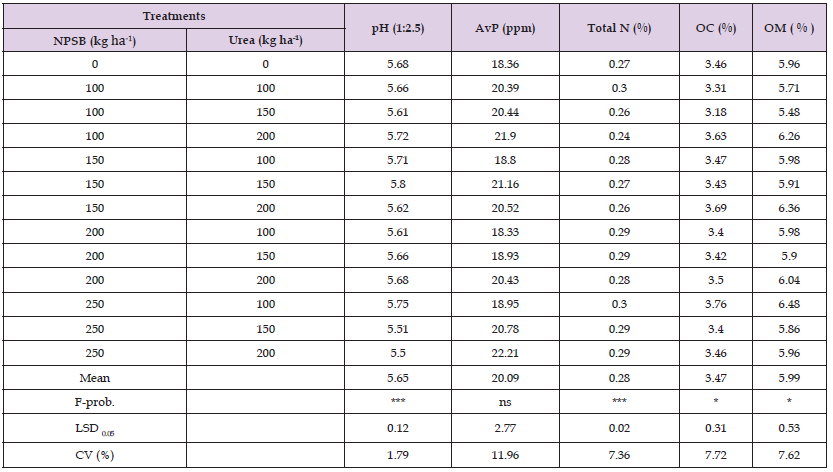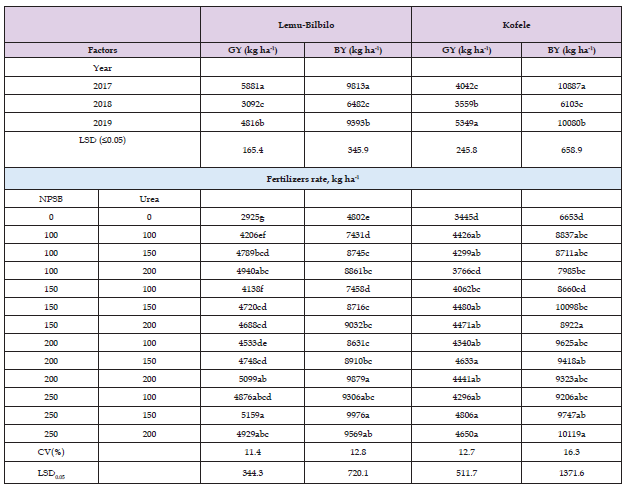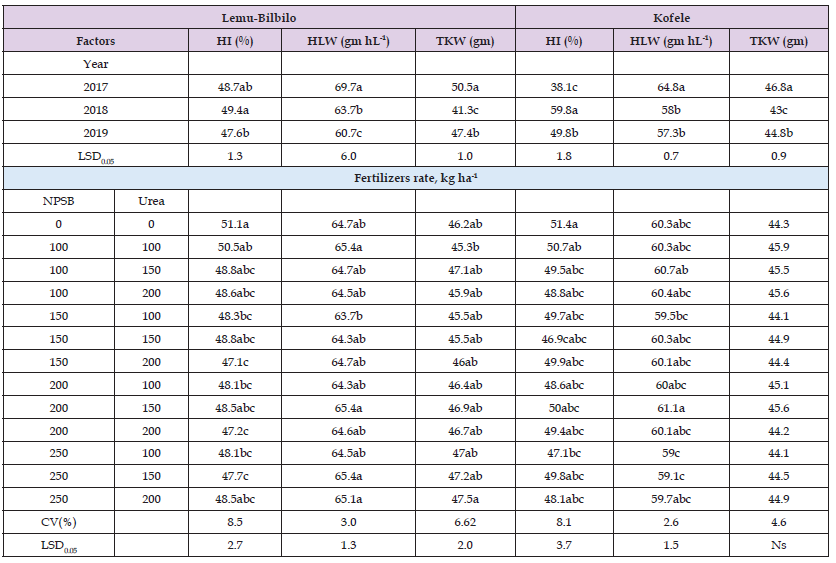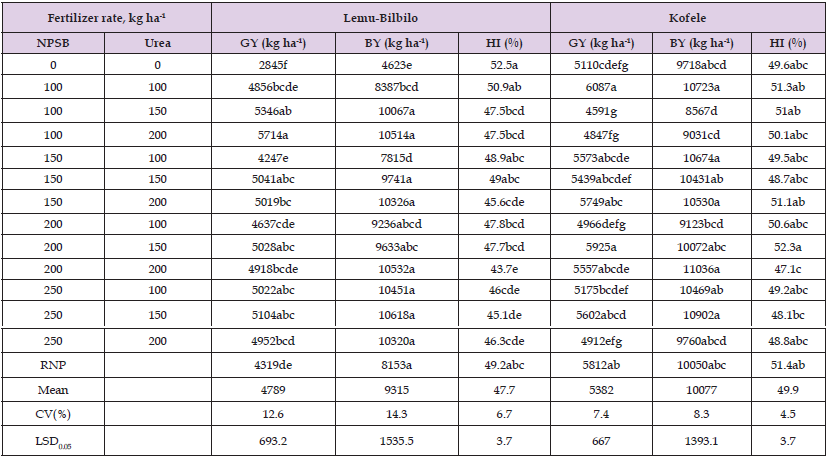Impact Factor : 0.548
- NLM ID: 101723284
- OCoLC: 999826537
- LCCN: 2017202541
Mengistu Chemeda*, Gobana Negasa, Dugasa Gerenfes and Kasu Tadesse
Received: March 27, 2024; Published: April 11, 2024
*Corresponding author: Mengistu Chemeda, Ethiopian Institute of Agricultural Research, Kulumsa Agricultural Research Center (EIAR/KARC), P.O.Box 489, Asella, Ethiopia
DOI: 10.26717/BJSTR.2024.56.008790
The Experiments were conducted in 2017 - 2019 cropping seasons on farmers' fields to determine optimum NPSB and urea fertilizers rate for Malt barley crop, and to assess economic feasibility of NPSB and urea fertilizers rate by using four levels of NPSB (0, 100, 150, 200, 250 kg ha-1 ),with three level urea (0, 100, 150, 200 kg ha-1) and recommended NP in combined RCBD with three replications on yield and yield components of malt barley. The soil analysis result of experimental sites at post-harvest showed, the application of treatments significantly (p < 0.05 and p < 0.001) affected pH, total N, and organic matter for samples taken from experimental sites of malt barley crop. Due to the application of different fertilizer levelsa significant improvement was observed in soil chemical contents compared to the contents of the soil before treatment application Lemu-Bilbilo district. Combined levels of NPSB and urea fertilizers rates was significantly affected grain and biomass yields at Lemu-Bilbilo and Kofele districts. The maximum grain and biomass yield (5881 and 9813 kg ha-1) in 2017 and minimum (3092 and 6482 kg ha-1) of malt barley in 2018 cropping season were obtained, respectively, at Lemu-Bilbilo district up on the application of NPSB and urea fertilizers. Similarly, significant grain and above ground biomass yield (5159 and 9976 kg ha-1) were obtained from the application of 250, 150 kg ha-1 NPSB, urea respectively. The highest grain and above ground biomass yield (5349 and 10887 kg ha-1) in 2019 and 2017, and lowest (4042 and 6103 kg ha-1) in 2017 and 2018 cropping season were obtained, respectively at Kofele district up on the application of NPSB and urea fertilizers. Similarly, significant grain and above ground biomass yield (4806 and 10119 kg ha-1) were obtained from the application of 250, 150 and 250, 200 kg ha-1 NPSB,urea, respectively.
Keywords: Experiment; NPSB and UREA Fertilizers; Malt Barley
Barley (Hordeum vulgare) is a very important grain which ranks fourth in both quantity produced and in area of cultivation of cereal crops in the world. The annual world harvest of barley in the late century was approximately 140 million tons from about 55 million ha. It is very versatile in every way and has well adapted through its evolution. The second largest use of barley is for malt. Barley is the primary cereal used in production of malt. Historically this may have resulted from its availability compared to that of other cereals, but there are several sound reasons for its use (Zhou MX [1]). It is a cool-season crop that is adapted to high altitudes, and grown in a wide range of agro-climatic regions under several production systems (Bekele B, et al. [2]). In Ethiopia barley is the major cereal crop grown by subsistence farmers in the highlands above 1800 m mainly under rainfed conditions with minimum or no external inputs (Ejigu [3]). Barley is produced mainly for human consumption and is one of the most important staple food crops. Barley straw is a good source of animal feed, especially during the dry season. It is also a useful material for thatching roofs of houses and for use as beddings (Grando, Macpherson [4]).
Efforts have been made so far to generate improved production technologies however, productivity of barley in production fields has remained very low in Ethiopia, which is 1.96 t ha-1 compared with the world average of 2.95 t ha-1 (CSA and USAD [5,6]). This is primarily due to the low yielding ability of farmers’ cultivars, which are the dominant varieties in use; the influence of several biotic and abiotic stresses; and the minimal promotion of improved barley production technologies. Several abiotic and biotic factors have contributed to this low productivity, such as poor crop management practices; the use of low yielding cultivars; the limited availability of the very few improved cultivars released; weeds, insects and diseases; and the inherently low yield potential of the prevalent local varieties (Bayeh, et al. [7]). Several researches have been conducted on high land areas of Ethiopia, like Bale, Arsi, Gojam, and central part of the country, there are as yet much barley producing highland areas starving of new technology, including improved varieties and appropriate rate of fertilizer (Wakene et al. [8]). Barley farmers in Ethiopia have not fully adopted modern inputs like fertilizer and modern seeds that help boost production (CSA, [9]). Sustaining soil and soil fertility in intensive cropping systems for higher yields and better quality can be achieved through optimum levels of fertilizer application. Thus, information on soil fertility status and crop response to different soil fertility management is very crucial to come up with profitable and sustainable crop production (Shahnaj et al., [10]).
In most regions of Ethiopia, soils are deficient in nitrogen and phosphorus, this aggravated by the long history of cultivation without any NP replenishment, which led to low soil fertility and low crop yields (Taye G, et al. [11]). Moreover, recently acquired soil inventory data revealed that the deficiencies of most of nutrients such as, nitrogen, phosphorus, sulfur, born and zinc are widespread in Ethiopian soils and similarly in the study area (EthioSIS, [12]). However, information on the application rate of blended fertilizer and urea was not determined for the study areas. As a result, this experiment was designed to investigate the response of malt barley to NPSB and Urea fertilizers with the specific objective of determine optimum NPSB and urea fertilizer rates for malt barley crop, soil, and climatic conditions.
Area Descriptions
The experiment was carried out on farmers’ fields and research stations for three cropping seasons during 2017-2019 at Lemu-Bilbilo and Kofele districts in Arsi zone of Oromia, South-eastern Ethiopia. Geographically, the study area is located between 070 36' 870" to 070 27' 530" N, and 0390 14' 270" to 0390 15' 133" E with an elevation ranging from 2526-2873 meters above sea level at Lemu-Bilbilo; and 070 56' 648"N latitude, 380 47' 584"E longitude at altitude of 2662 meters above sea level at Kofele district. The average weather data recorded on the weather station located near the study areas from the years 2017 - 2019 indicate that the total annual rainfall for Lemu-Bilbilo district were 956.6, 803.5 and 990.6 mm respectively, and the annual mean minimum and maximum daily air temperature for the consecutive years were (4.7, 2.9, 3.3 0C) and (18.5, 20.3, 20.5 0C) respectively.
Design and Treatments
The experiment was set in combined RCBD by varying levels of NPSB fertilizer (0, 100, 150, 200, 250 kg ha-1 ), and Urea (0, 100, 150, 200 kg ha-1) with three replications. The size of each experimental gross plot was 2.6 m * 4 m (10.4 m2). The malt barley variety used for the experiment at both locations was Ibon. Both fertilizers which varied depending on treatments were applied as side banding at sowing time, urea was applied two times in split half at planting and the remaining at 35 days after planting, the other agronomic practices were kept uniform for all treatments.
Soil Sampling and Analysis
Before and after harvesting, surface soil (0 - 20 cm depth) was collected from the entire experimental field. The soil was air dried every day and finely ground with a mortar and pestle. The fined soil was sieved through a 2mm sieve, and the pH, Available P, Total N, and Organic matter of the soil were determined at the Kulumsa Agricultural soil Laboratory. A pH meter was used to measure soil pH (H2O) in a 1:2.5 soil:water ratio. The Walkley-Black wet oxidation method was used to determine soil organic carbon. The micro-Kjeldahl digestion, distillation, and titration method was used to estimate total nitrogen, and the standard Olsen extraction method was used to determine available P. Accordingly, The soil analysis result before planting at Lemu-Bilbilo and Kofele districts indicated that the pH value were 5.64 (moderate) and 5.89 (moderate) (Foth and Ellis, 1997), available phosphorus were 11.35 ppm (high) and 8.19 ppm (medium), (Olsen et al., 1954), total N were 0.26 % (high) and 0.20 % (medium),and Organic matter 5.55 % (high) and 4.92 % (high), (Berhanu, 1982), respectively (Table 1).
Table 1: Mean value of some selected soil chemical properties selected from the experimental sites before planting at Lemu-Bilbilo and Kofele districts.

Yield and Yield Component Data Collection
Data of grain yield, above ground biomass, and thousand seed grain weight and hectoliter weight were collected from each plot. Grain and biomass yield and were analyzed gravimetrically by using sensitive balance and recorded in units of gram.
Statistical Analysis
The ANOVA procedure of statistical analysis system (SAS Institute, [13]) was used for performing the significance of differences in grain and above ground biomass yield parameters. A post hoc separation of means was done by least significant difference (LSD) test after main effects was found significant at P<0.05 [14-17].
Soil Chemical Properties of the Study Area Before and After Planting
The soil analysis results of experimental sites at harvest revealed that the application of treatments significantly (p < 0.05 and p < 0.001) affected pH, total N, and organic matter for samples taken from experimental sites of malt barley crop. Different fertilizer levels had significant effects on post-harvest pH and organic carbon content. There were no significant variations in P values among fertilizer-treated malt barley fields. At the Lemu-Bilbilo district, soil chemical contents improved significantly when compared to those before treatment application (Tables 1 & 2).
Table 2: Selected Soil chemical properties after harvesting of malt barley at Lemu-Bilbilo district.

Note: *, *** = significant at p < 0.05, and p < 0.001; ns = not significant.
Effect of NPSB and Urea Fertilizers on Grain and Biomass Yield of Malt Barley
The maximum grain and biomass yield (5881 and 9813 kg ha-1) in 2017 and minimum (3092 and 6482 kg ha-1) of malt barley in 2018 cropping season were obtained, respectively at Lemu-Bilbilo district up on the application of NPSB and urea fertilizers. Similarly, significant grain and above ground biomass yield (5159 and 9976 kg ha-1) were obtained from the application of 250 + 150 kg ha-1 NPSB + urea respectively (Table 3). The highest grain and biomass yield (5349 and 10887 kg ha-1) in 2019 and 2017, and lowest (4042 and 6103 kg ha-1) in 2017 and 2018 cropping season were obtained, respectively at Kofele district up on the application of NPSB and urea fertilizers. Similarly, significant grain and biomass yield (4806 and 10119 kg ha-1) were obtained from the application of (250, 150) and (250, 200) kg ha-1 NPSB and urea, respectively (Table 3). The mean Maximum value of harvest index (49.4 %) in 2018, HLW and thousand seed weight (69.7ghL-1, 50.5 g) in 2017, and mean minimum (47.6 %, 60.7 ghL-1) in 2019, and (41.3 g) in 2018 cropping season of malt barley were obtained, respectively at Lemu-Bilbilo district with application of NPSB and urea fertilizers. Similarly, significantly different result of harvest index (51.1 %), at the control, HLW (65.4 ghL-1), with the application of (100, 100), (250, 150), (250, 150), and thousand seed weight (47.5 g) with the application of (250, 200) kg ha-1 NPSB and urea were obtained, respectively (Table 4). The greatest value of harvest index (59.8 %) in 2018, HLW and thousand seed weight (64.8 ghL-1, 46.8 g) 2017, and lowest (38.1 %) in 2017, (57.3 ghL-1) in 2019 and (43.0 g) in 2018 cropping season were obtained, respectively at Kofele district with the application of NPSB and urea fertilizers. Similarly, significantly different value of harvest index (51.4 %), at the control, HLW (61.1 ghL-1) with the application of (200, 150) kg ha-1 NPSB and urea, respectively.
Table 3: Effect of NPSB and urea fertilizers on Grain) and biomass yield of malt barley at Lemu-Bilbilo and Kofele districts.

Further, the value of thousand seed weight was not significantly different among the treatments (Table 4). A one year (2019) malt barley study showed that the 100 and 200 kg ha-1 NPSB and urea fertilizer rates produced the highest grain and biomass yields (5714 and 10618 kg ha-1, respectively), while the controls and previous recommendations produced the lowest yields (2845 and 4623 kg ha-1 and 4319 and 8153 kg ha-1, respectively). Thus, the blanket recommendation has a grain yield advantage (34.1%) over the control and a yield loss of 6.9 to 24.4% over the other remaining treatments in the Lemu-Bilbilo district. Similarly, the application of (100, 100) and (250, 150) kg ha-1 NPSB and urea fertilizers showed the highest grain and above ground biomass yields (6087 and 10902 kg ha-1) and the lowest (4591 and 8567 kg ha-1) yields (4591 and 8567 kg ha-1). Thus, the blanket recommendations resulted in a grain yield loss (1.9 to 4.5%) compared to the other remaining treatments in the Kofele district (Table 5).
Table 4: Effect of NPSB and urea fertilizers on Harvest index hectoliter weight and thousand seed weight of malt barley at Lemu-Bilbilo and Kofele districts.

Table 5: Effect of NPSB and urea fertilizers on yield and yield related/component of malt barley at Lemu Bilbilo and Kofele districts (2019 cropping season).

Note: RNP = Recommended Nitrogen and Phosphorus
The soil analysis result of experimental sites at post-harvest showed that, the application of treatments significantly (p < 0.05 and p < 0.001) affected pH, total N, and organic matter for samples taken from experimental sites of malt barley crop. Application of different fertilizer levels had significant effects on post-harvest pH and organic carbon contents. Significant differences in P values were not observed among fertilizer level treated plots of malt barley. A significant improvement was observed in soil chemical contents compared to the contents of the soil before treatment application at Lemu-Bilbilo district. Maximum grain and biomass yield (5881 and 9813 kg ha-1) in 2017 and minimum (3092 and 6482 kg ha-1) of malt barley in 2018 cropping season were obtained, respectively at Lemu-Bilbilo district up on the application of NPSB and urea fertilizers. Similarly, significant grain and biomass yield (5159 and 9976 kg ha-1) were obtained from the application of 250 + 150 kg ha-1 NPSB + urea respectively. The highest grain and biomass yield (5349 and 10887 kg ha-1) in 2019 and 2017, and lowest (4042 and 6103 kg ha-1) in 2017 and 2018 cropping season were obtained, respectively at Kofele district up on the application of NPSB and urea fertilizers. Similarly, significant grain and biomass yield (4806 and 10119 kg ha-1) were obtained from the application of 250 + 150 and 250 + 200 kg ha-1 NPSB + urea, respectively.


